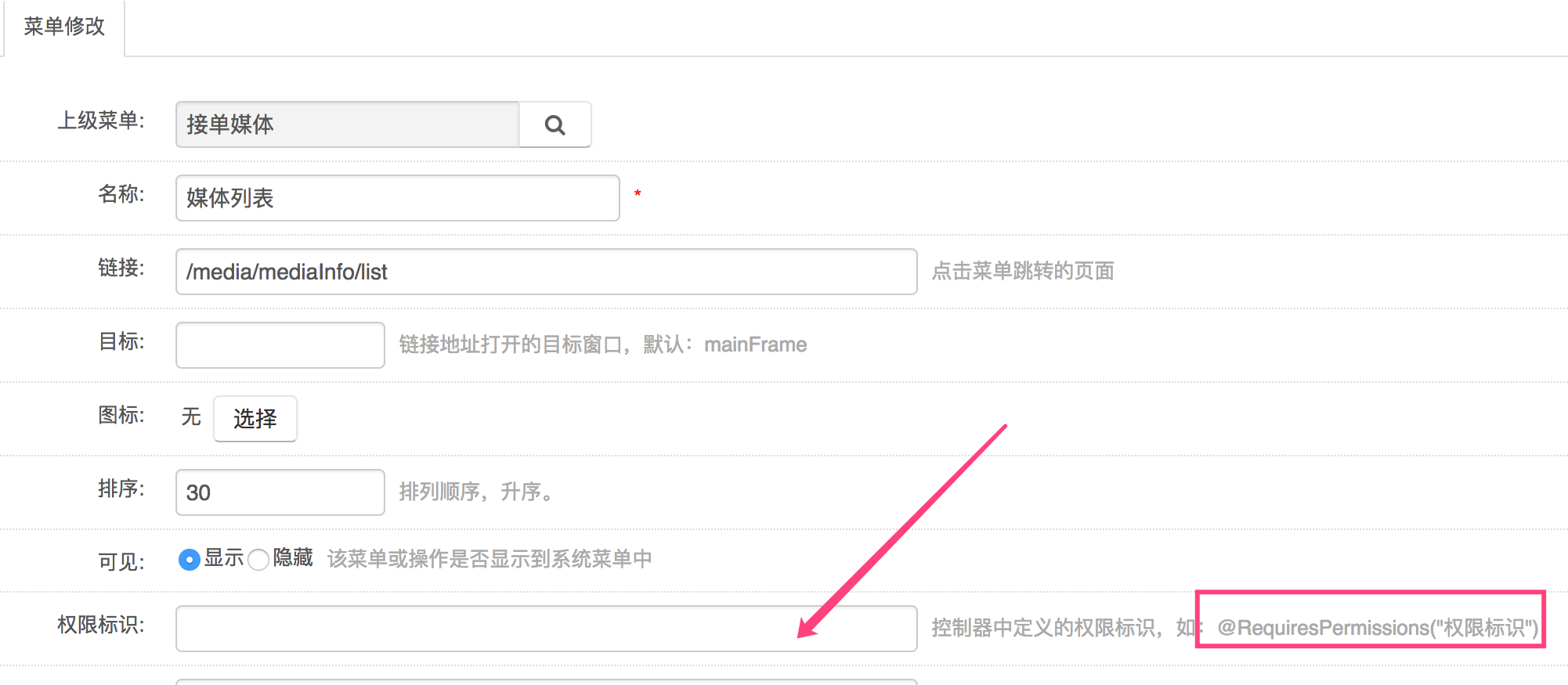1、这些值是存在数据库里的,在哪里找呢?sys_menu 中的permission列。
<shiro:hasPermission name="cms:article:edit">

他是怎么入库的呢?非菜单项的权限是怎么加入,怎么取出来使用的?
取出来的sql:
SELECT a.id , a.parent_id AS "parent.id" , a.parent_ids , a. NAME , a.href , a.target , a.icon , a.sort , a.is_show , a.permission , a.remarks , a.create_by AS "createBy.id" , a.create_date , a.update_by AS "updateBy.id" , a.update_date , a.del_flag , p. NAME AS "parent.name" FROM sys_menu a LEFT JOIN sys_menu p ON p.id = a.parent_id WHERE a.del_flag = 0 ORDER BY a.sort
同一个表里的id与parentid之间的连接;
程序代码是在:com.thinkgem.jeesite.modules.sys.security 这个包里
/**
* 授权查询回调函数, 进行鉴权但缓存中无用户的授权信息时调用
*/
@Override
protected AuthorizationInfo doGetAuthorizationInfo(PrincipalCollection principals) {
Principal principal = (Principal) getAvailablePrincipal(principals);
// 获取当前已登录的用户
if (!Global.TRUE.equals(Global.getConfig("user.multiAccountLogin"))){
Collection<Session> sessions = getSystemService().getSessionDao().getActiveSessions(true, principal, UserUtils.getSession());
if (sessions.size() > 0){
// 如果是登录进来的,则踢出已在线用户
if (UserUtils.getSubject().isAuthenticated()){
for (Session session : sessions){
getSystemService().getSessionDao().delete(session);
}
}
// 记住我进来的,并且当前用户已登录,则退出当前用户提示信息。
else{
UserUtils.getSubject().logout();
throw new AuthenticationException("msg:账号已在其它地方登录,请重新登录。");
}
}
}
User user = getSystemService().getUserByLoginName(principal.getLoginName());
if (user != null) {
SimpleAuthorizationInfo info = new SimpleAuthorizationInfo();
List<Menu> list = UserUtils.getMenuList();
for (Menu menu : list){
if (StringUtils.isNotBlank(menu.getPermission())){
// 添加基于Permission的权限信息
for (String permission : StringUtils.split(menu.getPermission(),",")){
info.addStringPermission(permission);
}
}
}
// 添加用户权限
info.addStringPermission("user");
// 添加用户角色信息
for (Role role : user.getRoleList()){
info.addRole(role.getEnname());
}
// 更新登录IP和时间
getSystemService().updateUserLoginInfo(user);
// 记录登录日志
LogUtils.saveLog(Servlets.getRequest(), "系统登录");
return info;
} else {
return null;
}
}
List<Menu> list = UserUtils.getMenuList();
for (Menu menu : list){ if (StringUtils.isNotBlank(menu.getPermission())){ // 添加基于Permission的权限信息 for (String permission : StringUtils.split(menu.getPermission(),",")){ info.addStringPermission(permission); } } }这一段;
3、那么JSP页面上是什么时候判断的呢?这些数据是什么时候初始化到数据库中的呢?
在使用Shiro标签库前,首先需要在JSP引入shiro标签:
<%@ taglib prefix="shiro" uri="/WEB-INF/tlds/shiros.tld" %>
当展示一个jsp页面时,页面中如果遇到<shiro:hasPermission name="item:update">,shiro调用realm获取数据库中的权限信息,看item:update是否在权限数据中存在,如果不存在就拒绝访问,如果存在就授权通过。
package com.thinkgem.jeesite.modules.sys.security;
import java.io.Serializable;
import java.util.Collection;
import java.util.List;
import javax.annotation.PostConstruct;
import org.apache.commons.lang3.StringUtils;
import org.apache.shiro.authc.AuthenticationException;
import org.apache.shiro.authc.AuthenticationInfo;
import org.apache.shiro.authc.AuthenticationToken;
import org.apache.shiro.authc.SimpleAuthenticationInfo;
import org.apache.shiro.authc.credential.HashedCredentialsMatcher;
import org.apache.shiro.authz.AuthorizationInfo;
import org.apache.shiro.authz.Permission;
import org.apache.shiro.authz.SimpleAuthorizationInfo;
import org.apache.shiro.realm.AuthorizingRealm;
import org.apache.shiro.session.Session;
import org.apache.shiro.subject.PrincipalCollection;
import org.apache.shiro.util.ByteSource;
import org.slf4j.Logger;
import org.slf4j.LoggerFactory;
import org.springframework.stereotype.Service;
import com.thinkgem.jeesite.common.config.Global;
import com.thinkgem.jeesite.common.servlet.ValidateCodeServlet;
import com.thinkgem.jeesite.common.utils.Encodes;
import com.thinkgem.jeesite.common.utils.SpringContextHolder;
import com.thinkgem.jeesite.common.web.Servlets;
import com.thinkgem.jeesite.modules.sys.entity.Menu;
import com.thinkgem.jeesite.modules.sys.entity.Role;
import com.thinkgem.jeesite.modules.sys.entity.User;
import com.thinkgem.jeesite.modules.sys.service.SystemService;
import com.thinkgem.jeesite.modules.sys.utils.LogUtils;
import com.thinkgem.jeesite.modules.sys.utils.UserUtils;
import com.thinkgem.jeesite.modules.sys.web.LoginController;
/**
* 系统安全认证实现类
* @author ThinkGem
* @version 2014-7-5
*/
@Service
//@DependsOn({"userDao","roleDao","menuDao"})
public class SystemAuthorizingRealm extends AuthorizingRealm {
private Logger logger = LoggerFactory.getLogger(getClass());
private SystemService systemService;
public SystemAuthorizingRealm() {
this.setCachingEnabled(false);
}
/**
* 认证回调函数, 登录时调用
*/
@Override
protected AuthenticationInfo doGetAuthenticationInfo(AuthenticationToken authcToken) {
UsernamePasswordToken token = (UsernamePasswordToken) authcToken;
int activeSessionSize = getSystemService().getSessionDao().getActiveSessions(false).size();
if (logger.isDebugEnabled()){
logger.debug("login submit, active session size: {}, username: {}", activeSessionSize, token.getUsername());
}
// 校验登录验证码
if (LoginController.isValidateCodeLogin(token.getUsername(), false, false)){
Session session = UserUtils.getSession();
String code = (String)session.getAttribute(ValidateCodeServlet.VALIDATE_CODE);
if (token.getCaptcha() == null || !token.getCaptcha().toUpperCase().equals(code)){
throw new AuthenticationException("msg:验证码错误, 请重试.");
}
}
// 校验用户名密码
User user = getSystemService().getUserByLoginName(token.getUsername());
if (user != null) {
if (Global.NO.equals(user.getLoginFlag())){
throw new AuthenticationException("msg:该已帐号禁止登录.");
}
byte[] salt = Encodes.decodeHex(user.getPassword().substring(0,16));
return new SimpleAuthenticationInfo(new Principal(user, token.isMobileLogin()),
user.getPassword().substring(16), ByteSource.Util.bytes(salt), getName());
} else {
return null;
}
}
/**
* 获取权限授权信息,如果缓存中存在,则直接从缓存中获取,否则就重新获取, 登录成功后调用
*/
protected AuthorizationInfo getAuthorizationInfo(PrincipalCollection principals) {
if (principals == null) {
return null;
}
AuthorizationInfo info = null;
info = (AuthorizationInfo)UserUtils.getCache(UserUtils.CACHE_AUTH_INFO);
if (info == null) {
info = doGetAuthorizationInfo(principals);
if (info != null) {
UserUtils.putCache(UserUtils.CACHE_AUTH_INFO, info);
}
}
return info;
}
/**
* 授权查询回调函数, 进行鉴权但缓存中无用户的授权信息时调用
*/
@Override
protected AuthorizationInfo doGetAuthorizationInfo(PrincipalCollection principals) {
Principal principal = (Principal) getAvailablePrincipal(principals);
// 获取当前已登录的用户
if (!Global.TRUE.equals(Global.getConfig("user.multiAccountLogin"))){
Collection<Session> sessions = getSystemService().getSessionDao().getActiveSessions(true, principal, UserUtils.getSession());
if (sessions.size() > 0){
// 如果是登录进来的,则踢出已在线用户
if (UserUtils.getSubject().isAuthenticated()){
for (Session session : sessions){
getSystemService().getSessionDao().delete(session);
}
}
// 记住我进来的,并且当前用户已登录,则退出当前用户提示信息。
else{
UserUtils.getSubject().logout();
throw new AuthenticationException("msg:账号已在其它地方登录,请重新登录。");
}
}
}
User user = getSystemService().getUserByLoginName(principal.getLoginName());
if (user != null) {
SimpleAuthorizationInfo info = new SimpleAuthorizationInfo();
List<Menu> list = UserUtils.getMenuList();
for (Menu menu : list){
if (StringUtils.isNotBlank(menu.getPermission())){
// 添加基于Permission的权限信息
for (String permission : StringUtils.split(menu.getPermission(),",")){
info.addStringPermission(permission);
}
}
}
// 添加用户权限
info.addStringPermission("user");
// 添加用户角色信息
for (Role role : user.getRoleList()){
info.addRole(role.getEnname());
}
// 更新登录IP和时间
getSystemService().updateUserLoginInfo(user);
// 记录登录日志
LogUtils.saveLog(Servlets.getRequest(), "系统登录");
return info;
} else {
return null;
}
}
@Override
protected void checkPermission(Permission permission, AuthorizationInfo info) {
authorizationValidate(permission);
super.checkPermission(permission, info);
}
@Override
protected boolean[] isPermitted(List<Permission> permissions, AuthorizationInfo info) {
if (permissions != null && !permissions.isEmpty()) {
for (Permission permission : permissions) {
authorizationValidate(permission);
}
}
return super.isPermitted(permissions, info);
}
@Override
public boolean isPermitted(PrincipalCollection principals, Permission permission) {
authorizationValidate(permission);
return super.isPermitted(principals, permission);
}
@Override
protected boolean isPermittedAll(Collection<Permission> permissions, AuthorizationInfo info) {
if (permissions != null && !permissions.isEmpty()) {
for (Permission permission : permissions) {
authorizationValidate(permission);
}
}
return super.isPermittedAll(permissions, info);
}
/**
* 授权验证方法
* @param permission
*/
private void authorizationValidate(Permission permission){
// 模块授权预留接口
}
/**
* 设定密码校验的Hash算法与迭代次数
*/
@PostConstruct
public void initCredentialsMatcher() {
HashedCredentialsMatcher matcher = new HashedCredentialsMatcher(SystemService.HASH_ALGORITHM);
matcher.setHashIterations(SystemService.HASH_INTERATIONS);
setCredentialsMatcher(matcher);
}
// /**
// * 清空用户关联权限认证,待下次使用时重新加载
// */
// public void clearCachedAuthorizationInfo(Principal principal) {
// SimplePrincipalCollection principals = new SimplePrincipalCollection(principal, getName());
// clearCachedAuthorizationInfo(principals);
// }
/**
* 清空所有关联认证
* @Deprecated 不需要清空,授权缓存保存到session中
*/
@Deprecated
public void clearAllCachedAuthorizationInfo() {
// Cache<Object, AuthorizationInfo> cache = getAuthorizationCache();
// if (cache != null) {
// for (Object key : cache.keys()) {
// cache.remove(key);
// }
// }
}
/**
* 获取系统业务对象
*/
public SystemService getSystemService() {
if (systemService == null){
systemService = SpringContextHolder.getBean(SystemService.class);
}
return systemService;
}
/**
* 授权用户信息
*/
public static class Principal implements Serializable {
private static final long serialVersionUID = 1L;
private String id; // 编号
private String loginName; // 登录名
private String name; // 姓名
private boolean mobileLogin; // 是否手机登录
// private Map<String, Object> cacheMap;
public Principal(User user, boolean mobileLogin) {
this.id = user.getId();
this.loginName = user.getLoginName();
this.name = user.getName();
this.mobileLogin = mobileLogin;
}
public String getId() {
return id;
}
public String getLoginName() {
return loginName;
}
public String getName() {
return name;
}
public boolean isMobileLogin() {
return mobileLogin;
}
// @JsonIgnore
// public Map<String, Object> getCacheMap() {
// if (cacheMap==null){
// cacheMap = new HashMap<String, Object>();
// }
// return cacheMap;
// }
/**
* 获取SESSIONID
*/
public String getSessionid() {
try{
return (String) UserUtils.getSession().getId();
}catch (Exception e) {
return "";
}
}
@Override
public String toString() {
return id;
}
}
}
怎么入库的呢?看截图,还是菜单管理中的操作:

4、控制器controller中的权限控制,对应在后台添加菜单时,需要在控制器的方法上添加注解:


@RequiresPermissions("cms:view")

对应后台添加菜单时:
